I See You.
Character Visibility.
Welcome to this week’s #TuesdayTip. Today, I want to look at character visibility.
Specifically, whether a character is front and centre or ‘hidden’ in the background.
In crime novels, there is usually a culprit of some description. There are also red herrings. Fans of crime fiction are often very careful readers. They are looking for clues as to who the antagonist is. I’ve discussed previously the placement of red herrings [Tip153] but sometimes you want to mislead your readers even more. You want readers to work for the pay off. One way to do this is to keep them guessing about whether the guilty party is front and centre throughout the story (hiding in plain sight) or perhaps is a smaller character, maybe one that seems to be little more than a supporting actor.
Although there are very few hard and fast rules about writing crime fiction, one thing you have to do is introduce the culprit early on – don’t cheat and bring them in two chapters from the end.
So, do you have them as a key part of the narrative, or do you slip them in barely noticed?
The same goes for red herrings. Do you make them an obvious suspect and spend most of the book making the readers guess ‘are they or aren’t they’, only to fall at the final hurdle? Or do you slip them in discreetly early on, but have them just noticeable enough that the reader starts to feel clever because they think they’ve spotted someone you are trying to hide?
Some of the best books I’ve ever read skilfully combine both approaches. A character who is so obvious that I am almost dismissing them, because surely the writer is trying to mislead me? Alongside an apparently minor character who I start to feel suspicious about, solely because I think ‘well they must be there for a reason …’.
Another approach is to have more than one culprit. The obvious suspect turns out to be the evildoer, but they are dismissed at one point because they couldn’t have done it (eg they had an alibi) or their motive collapses. You then reveal that they did do it, but for a different reason and enlisted the help of someone else, either to give them a false alibi or to carry out the deed on their behalf. Lovers of True Crime see this all the time. The woman whose husband is killed whilst she is twenty miles away in a crowded bar, turns out to have been murdered by her lover so that they can live happily ever, after is a typical example.
Just one final thought. I have focused here on the culprit, but what about the unexpected hero? This has to be done with care, to avoid stereotypes and ‘saviour tropes’ (eg the damsel in distress is rescued by the big, handsome man). However, when done well, it can work brilliantly . For example our protagonist luckily avoids danger or has unexpected clues fall into their lap, and it is eventually revealed that they had an unknown helper all along. Especially if the helper is the person you’d least expect to be on their side.
What do you think about character visibility? Do you like the culprit to be hidden in plain sight or a part of the background? As always, feel free to comment here or on social media.
Until next time,
Paul.
If you are a writer with a tip to share, or fancy writing a fictional interview between you and one of your characters, please feel free to email me.
Specifically, whether a character is front and centre or ‘hidden’ in the background.
In crime novels, there is usually a culprit of some description. There are also red herrings. Fans of crime fiction are often very careful readers. They are looking for clues as to who the antagonist is. I’ve discussed previously the placement of red herrings [Tip153] but sometimes you want to mislead your readers even more. You want readers to work for the pay off. One way to do this is to keep them guessing about whether the guilty party is front and centre throughout the story (hiding in plain sight) or perhaps is a smaller character, maybe one that seems to be little more than a supporting actor.
Although there are very few hard and fast rules about writing crime fiction, one thing you have to do is introduce the culprit early on – don’t cheat and bring them in two chapters from the end.
So, do you have them as a key part of the narrative, or do you slip them in barely noticed?
The same goes for red herrings. Do you make them an obvious suspect and spend most of the book making the readers guess ‘are they or aren’t they’, only to fall at the final hurdle? Or do you slip them in discreetly early on, but have them just noticeable enough that the reader starts to feel clever because they think they’ve spotted someone you are trying to hide?
Some of the best books I’ve ever read skilfully combine both approaches. A character who is so obvious that I am almost dismissing them, because surely the writer is trying to mislead me? Alongside an apparently minor character who I start to feel suspicious about, solely because I think ‘well they must be there for a reason …’.
Another approach is to have more than one culprit. The obvious suspect turns out to be the evildoer, but they are dismissed at one point because they couldn’t have done it (eg they had an alibi) or their motive collapses. You then reveal that they did do it, but for a different reason and enlisted the help of someone else, either to give them a false alibi or to carry out the deed on their behalf. Lovers of True Crime see this all the time. The woman whose husband is killed whilst she is twenty miles away in a crowded bar, turns out to have been murdered by her lover so that they can live happily ever, after is a typical example.
Just one final thought. I have focused here on the culprit, but what about the unexpected hero? This has to be done with care, to avoid stereotypes and ‘saviour tropes’ (eg the damsel in distress is rescued by the big, handsome man). However, when done well, it can work brilliantly . For example our protagonist luckily avoids danger or has unexpected clues fall into their lap, and it is eventually revealed that they had an unknown helper all along. Especially if the helper is the person you’d least expect to be on their side.
What do you think about character visibility? Do you like the culprit to be hidden in plain sight or a part of the background? As always, feel free to comment here or on social media.
Until next time,
Paul.
If you are a writer with a tip to share, or fancy writing a fictional interview between you and one of your characters, please feel free to email me.




















